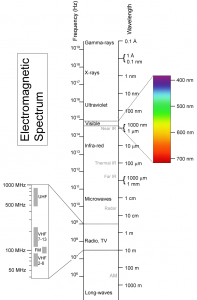Ever wonder what makes OttLite lighting superior to the competition? Well, wonder not! This 3-part blog series is going to tell you all you need to know about OttLite’s 508® Natural Daylight Illumination.
The science behind our 508® Natural Daylight Illumination starts not with our unique blend of rare-earth phosphors, or the tiny dot of mercury found in all CFL bulbs, or even the sun. It all starts with the human eye. In order to develop the perfect light, our scientists first had to understand how the eyes perceive light and what factors affect that perception.
What is light?
Light is part of the same electromagnetic spectrum as radio waves, microwaves, x-rays, etc. That is to say it is a wave of energy. We call light “full-spectrum light” when it emits energy across the entire visual sensitivity spectrum.
 How do we perceive light?
How do we perceive light?
We all learned in school about how rods and cones in our eyes affect our vision. Originally it was thought that scotopic vision—the rods—were only active during low-light levels, while photopic—the cones—were active during normal lighting and when perceiving color. Studies have since proven this explanation to be overly simplistic. The truth is that both our scotopic and photopic sensitivities are active during normal daylight vision.
Photopic sensitivity peaks at 555nm; scotopic sensitivity peaks at 508nm. It is the scotopic/photopic sensitivity ratio (s/p) that defines how we see fine details and colors.
Things to remember…
- • Scotopic vision is sensitive to black-and-white contrast. This is critical in fine-detail vision.
- • Photopic vision is sensitive to color value, thus it is essential in determining acuity of color vision.
What about lumens?
A lumen is a measurement of light energy
as perceived by your eye. Here’s a short example of how a lumen is different from a watt:
Let’s say you had four light sources all emitting 1 watt of energy. One light is blue, one is red, one is yellow, and one is green. Even though all four light sources are emitting the same wattage, your eyes will perceive the green light as the brightest. It will see the highest lumens out of the green light. Why? Your eyes are more sensitive to the green areas of the spectrum.
Full-spectrum lighting does lose lumens in comparison to standard lighting, but it is an acceptable loss. You need the full spectrum of light wavelengths on the visual sensitivity spectrum in order see colors
and black-and-white details clearly.
Next Week:
But wait, there’s more…

You need to
login to comment.